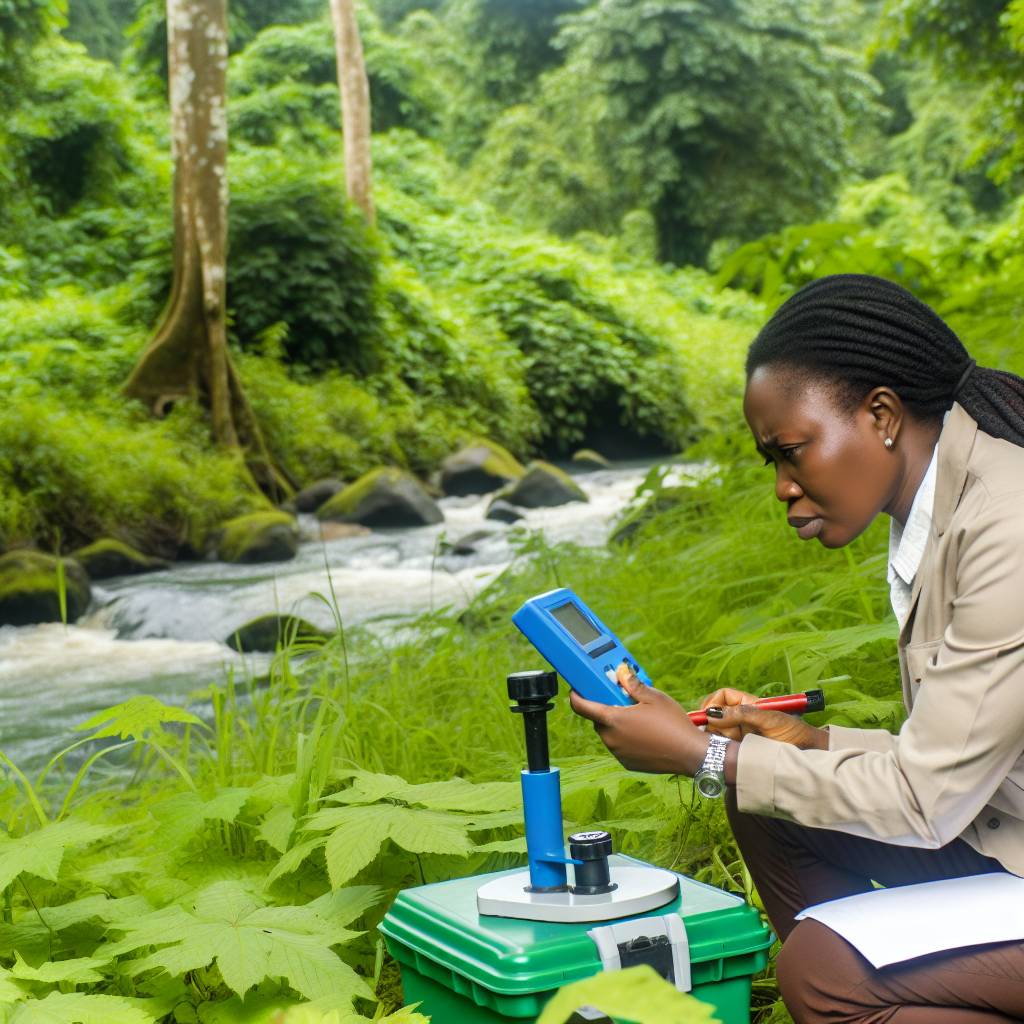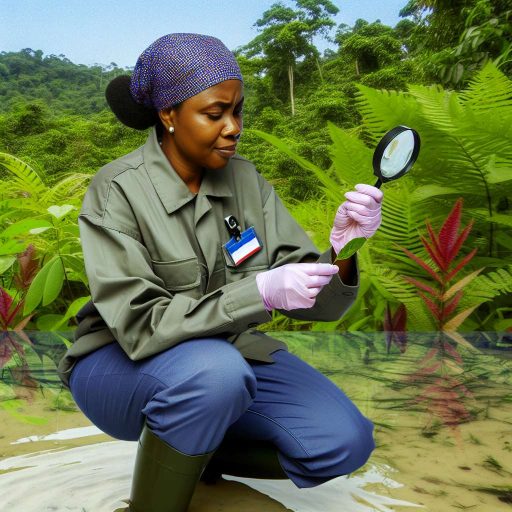Introduction:
Environmental Impact Assessments (EIAs) are essential tools in assessing potential impacts on the environment in biology.
In Nigeria, EIAs are crucial for conserving the environment.
Importance of EIAs in Biology:
EIAs help in evaluating the impact of human activities on ecosystems, species, and overall biodiversity.
They provide valuable data for conservation efforts.
Nigeria, with its rich biodiversity, benefits significantly from conducting EIAs.
Relevance of EIAs in Nigeria:
In Nigeria, EIAs play a vital role in safeguarding the diverse ecosystems present in the country.
They help in identifying potential threats to species and habitats.
Conducting EIAs ensures sustainable development while preserving the environment for future generations.
History of Environmental Impact Assessments in Nigeria:
Environmental Impact Assessments (EIAs) in Nigeria have evolved significantly over the years.
The first official recognition of EIAs in Nigeria can be traced back to the Environmental Impact Assessment Decree of 1992.
This decree was a landmark legislation that laid the foundation for the systematic assessment of the environmental impacts of development projects in the country.
Subsequently, the Environmental Impact Assessment Act of 1992 was enacted to provide a legal framework for the implementation of EIAs in Nigeria.
The Act mandated developers to prepare and submit environmental impact statements for proposed projects to the relevant regulatory agencies for approval.
Key Milestones in the Evolution of EIAs in Nigeria:
- Establishment of the Federal Environmental Protection Agency (FEPA) in 1988.
- Integration of Environmental Impact Assessments into the planning and decision-making processes for development projects.
- Revision of the EIA legislation in 1999 to align with international best practices and standards.
- Introduction of Strategic Environmental Assessments (SEAs) to address cumulative impacts of policies, plans, and programs in 2003.
- Creation of the National Environmental Standards and Regulations Enforcement Agency (NESREA) in 2007 to oversee EIAs in Nigeria.
The evolution of EIAs in Nigeria reflects a growing awareness of the importance of environmental protection and sustainable development.
EIAs have become a crucial tool for ensuring that development projects in Nigeria are implemented in a manner that minimizes adverse environmental impacts.
By assessing the potential environmental impacts of projects before they are implemented, EIAs help decision-makers make informed choices that balance economic development with environmental conservation.
Changes in Regulations Governing EIAs in Nigeria:
- Shift from voluntary to mandatory EIA compliance for certain categories of projects.
- Inclusion of public participation in the EIA process to promote transparency and stakeholder engagement.
- Recognition of the role of Non-Governmental Organizations (NGOs) in monitoring compliance with EIA requirements.
- Emphasis on monitoring and evaluation of projects to ensure compliance with approved EIA recommendations.
- Integration of climate change considerations into the EIA process to address emerging environmental challenges.
The changes in regulations governing EIAs in Nigeria reflect a continuous effort to improve the effectiveness and efficiency of the EIA process.
The goal is to enhance environmental protection, promote sustainable development, and ensure that Nigeria’s natural resources are managed responsibly for future generations.
Laws and Policies Governing EIAs in Nigeria
The Environmental Impact Assessment Act is the primary legislation that governs EIAs in Nigeria.
This Act requires that any proposed project with potential environmental impacts must undergo an EIA before approval.
The Act empowers the Federal Ministry of Environment to regulate and oversee the EIA process.
Furthermore, the National Environmental Standards and Regulations Enforcement Agency (NESREA) plays a role in enforcing EIA compliance.
Role of Government Agencies in Enforcing EIA Compliance
The Federal Ministry of Environment is responsible for ensuring that EIAs are conducted for all development projects.
It reviews EIA reports to determine the potential environmental and social impacts of proposed projects.
The Ministry also monitors the implementation of EIA recommendations to mitigate negative impacts on the environment.
NESREA works in collaboration with the Ministry to enforce compliance with EIA regulations and guidelines.
Both agencies work together to ensure that developers adhere to best practices in environmental management.
The legal framework for EIAs in Nigeria is robust.
There are clear laws and policies in place to guide the process.
Government agencies like the Federal Ministry of Environment and NESREA play a critical role in enforcing EIA compliance.
They promote sustainable development in the country.
Uncover the Details: Top Nigerian Universities for Agricultural Science
Process of Conducting an Environmental Impact Assessment in Nigeria:
1. Scoping:
– Identify the key environmental issues to be addressed in the assessment.
– Define the boundaries, scope, and objectives of the EIA.
2. Baseline Data Collection:
– Gather information on the current state of the environment in the project area.
– Assess potential impacts the project may have on the environment.
3. Impact Prediction and Evaluation:
– Predict and evaluate potential environmental impacts of the project.
Transform Your Career with Expert Guidance
Get personalized mentorship consulting that’s tailored to your unique path. Our expert advice is actionable and exclusive.
Get Started– Determine the significance of these impacts on the environment.
4. Mitigation Measures:
– Develop strategies to mitigate or minimize the identified impacts.
– Ensure that the project design includes these measures.
5. Alternatives Analysis:
– Evaluate alternative options to the proposed project.
– Compare the environmental impacts of different scenarios.
6. Environmental Management Plan:
– Develop an environmental management plan to guide project implementation.
– Include monitoring, reporting, and enforcement mechanisms.
7. Stakeholder Engagement:
– Engage with local communities, government agencies, and other stakeholders.
– Seek input and feedback to inform decision-making.
8. Public Participation:
– Conduct public consultations and hearings to gather input.
– Ensure that the concerns and opinions of the public are considered.
9. Review and Approval:
– Submit the EIA report to the relevant regulatory authority for review.
– Obtain approval before proceeding with the project.
10. Monitoring and Compliance:
– Implement the environmental management plan during project execution.
– Monitor environmental impacts and ensure compliance with regulations.
Importance of Stakeholder Engagement and Public Participation:
– Enhances transparency and accountability in the decision-making process.
– Ensures that diverse perspectives and local knowledge are considered.
– Builds trust and fosters positive relationships with communities.
– Helps to identify potential issues and address concerns early on.
– Strengthens the overall effectiveness and legitimacy of the EIA process.
Find Out More: Balancing Applied Math Studies and Personal Life
Challenges and Limitations of Environmental Impact Assessments in Nigeria:
When it comes to conducting Environmental Impact Assessments (EIAs) in Nigeria, there are several challenges and limitations that hinder the effectiveness of these assessments.
Some of the common obstacles faced include:
Inadequate Funding:
-
Lack of financial resources to carry out comprehensive EIAs.
-
This leads to rushed assessments and potential oversight of critical environmental concerns.
Capacity Constraints:
-
Shortage of skilled professionals with expertise in conducting EIAs.
-
This results in delays in the assessment process and a lack of quality in the reports.
While these challenges are significant, there are also limitations to consider when it comes to the effectiveness of EIAs in addressing cumulative impacts and climate change-related concerns:
Cumulative Impacts:
-
EIAs often focus on individual projects rather than considering the cumulative effects of multiple projects.
-
This can result in an underestimation of the overall environmental impact of development activities.
Climate Change-related Concerns:
-
Traditional EIAs may not adequately assess the long-term effects of projects on climate change.
-
As climate change becomes a growing global concern, the need for more thorough assessments is crucial.
Addressing the challenges and limitations of EIAs in Nigeria requires a multi-faceted approach that involves increasing funding, improving capacity-building efforts, and enhancing the scope of assessments to include cumulative impacts and climate change-related concerns.
Explore Further: Future Trends in Nigerian Geophysics Industry

Case Studies of Successful Environmental Impact Assessments in Nigeria
One notable example of a successful EIA in Nigeria is the assessment conducted for the Lekki Conservation Centre.
The EIA for the Lekki Conservation Centre provided valuable insights into the biodiversity of the area and helped in the development of conservation strategies.
This assessment positively influenced biodiversity conservation by highlighting the importance of protecting the unique flora and fauna found in the region.
As a result of the EIA, the Lekki Conservation Centre was able to implement sustainable management practices to preserve the ecosystem and promote ecotourism.
Another successful case study is the EIA conducted for the Omo Forest Reserve in Nigeria.
The EIA for the Omo Forest Reserve led to the identification of key areas for ecosystem restoration and the protection of endangered species in the region.
By highlighting the ecological value of the Omo Forest Reserve, the EIA played a key role in advocating for sustainable management practices in the area.
The successful implementation of the recommendations from the EIA has contributed to the sustainable management of natural resources in the Omo Forest Reserve.
Additionally, the EIA helped in raising awareness about the importance of protecting biodiversity and ecosystems in Nigeria.
Overall, these case studies demonstrate the positive impact of effective EIAs in promoting biodiversity conservation and ecosystem restoration in Nigeria.
Gain More Insights: Tools and Techniques Used in Nigerian Archaeology
Biologists play a crucial role in Environmental Impact Assessments (EIAs) in Nigeria.
Their expertise is essential in assessing ecological impacts and biodiversity conservation.
Contributions of Biologists in EIAs
- Biologists conduct field surveys to assess the existing flora and fauna in the project area.
- They analyze the potential impacts of the proposed development on biodiversity and ecosystems.
- Biologists help in identifying sensitive areas that need special protection measures.
- They provide recommendations for mitigating the negative effects on wildlife and habitats.
- Biologists contribute to the monitoring and evaluation of the environmental impacts over time.
Interdisciplinary Collaboration in EIA Processes
Collaboration between biologists, environmental scientists, and policymakers is essential for effective EIAs.
- Biologists provide valuable insights into the ecological aspects of the project.
- Environmental scientists contribute expertise in assessing pollution and resource management.
- Policymakers utilize the scientific findings to formulate regulations and guidelines.
- Interdisciplinary collaboration ensures a comprehensive understanding of the project’s environmental implications.
- It enhances the decision-making process by incorporating diverse perspectives and expertise.
Biologists play a critical role in Environmental Impact Assessments in Nigeria, focusing on ecological impacts and biodiversity conservation.
Collaboration between different disciplines is vital for ensuring sustainable development and environmental protection.
Importance of Environmental Impact Assessments
Ensuring effective Environmental Impact Assessments (EIAs) in Nigerian biology is crucial for sustainable development and biodiversity conservation.
By analyzing and evaluating the potential impacts of projects, we can mitigate negative consequences and protect our environment.
It is imperative that stakeholders, policymakers, and researchers continue to advocate for the implementation of robust EIAs.
Through improved environmental management practices and regulatory frameworks, we can ensure the long-term health of Nigeria’s ecosystems.
Ultimately, the integration of EIAs into biological studies is essential for promoting responsible development and maintaining ecological balance.
Additional Resources
Assessing awareness on biodiversity conservation among Nigerians …
Synthetic Biology in Nigeria: The Level of Awareness amongst …




